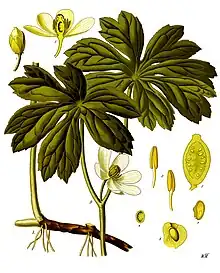Teniposide
 | |
| Names | |
|---|---|
| Trade names | Vumon |
| Other names | VM-26 |
IUPAC name
| |
| Clinical data | |
| Drug class | Podophyllotoxin derivative[1] |
| Main uses | Acute lymphocytic leukemia (ALL)[1] |
| Side effects | Low white blood cells, low red blood cells, low platelets, inflammation in the mouth, nausea, hair loss, bleeding, fever, allergic reactions[1] |
| Pregnancy category |
|
| Routes of use | Intravenous |
| External links | |
| AHFS/Drugs.com | Monograph |
| US NLM | Teniposide |
| MedlinePlus | a692045 |
| Legal | |
| Legal status |
|
| Pharmacokinetics | |
| Bioavailability | N/A |
| Protein binding | >99% |
| Metabolism | Liver (CYP2C19-mediated) |
| Elimination half-life | 5 hours |
| Excretion | Kidney and fecal |
| Chemical and physical data | |
| Formula | C32H32O13S |
| Molar mass | 656.66 g·mol−1 |
| 3D model (JSmol) | |
SMILES
| |
InChI
| |
Teniposide, sold under the brand name Vumon, is a chemotherapy medication used to treat acute lymphocytic leukemia (ALL) in children.[1] It is a second line agent for this use.[1] Other uses may include small cell lung cancer and lymphoma.[2] It is given by injection into a vein.[1]
Common side effects include low white blood cells, low red blood cells, low platelets, inflammation in the mouth, nausea, hair loss, bleeding, fever, and allergic reactions.[1] Other side effects may include other cancers, tissue death at the site of injection, and low blood pressure.[1] Use in pregnancy may harm the baby.[1] It is in a class of drugs known as podophyllotoxin derivatives and is believed to work by interfering with the production of DNA.[1]
Teniposide was approved for medical use in the United States in 1992.[1] It has been sold in Europe since 1967 and Canada since 1984.[2][3] In the United States it costs about 2,100 USD per 50 mg dose as of 2021.[4] It is no longer commercially available in Canada.[3]
Medical uses
Teniposide is used for the treatment of a number of cancer types in children. In the US, it is approved for the second-line therapy of acute lymphocytic leukemia (ALL) in combination with other antineoplastic drugs.[5] In Europe, it is also approved for the treatment of Hodgkin's lymphoma, generalized malignant lymphoma, reticulocyte sarcoma, acute leukaemia, primary brain tumours (glioblastoma, ependymoma, astrocytoma), bladder cancer, neuroblastoma and other solid tumours in children.[6]
Dosage
The medication is injected though a vein and burns if it leaks under the skin. It can be used in combination with other anticancer drugs.[6]
Contraindications
The drug is contraindicated during pregnancy and lactation, in patients with severe liver or kidney impairment or severely impaired haematopoiesis.[6]
Side effects
Teniposide, when used with other chemotherapeutic agents for the treatment of ALL, results in severe bone marrow suppression. Other common side effects include gastrointestinal toxicity, hypersensitivity reactions, and reversible alopecia.[6]
Interactions
No systematic interaction studies are available. The enzyme inducers phenobarbital and phenytoin have been found to lower its blood plasma concentrations.[7] Theoretically possible interactions include increased plasma concentrations when combined with sodium salicylate, sulfamethizole or tolbutamide, which displace teniposide from plasma protein binding, at least in vitro.[6][5]
Pharmacology
Mechanism of action
Teniposide causes dose-dependent single- and double-stranded breaks in DNA and DNA-protein cross-links.[6] The substance has been found to act as an inhibitor of topoisomerase II (an enzyme that aids in DNA unwinding),[7][8] since it does not intercalate into DNA or bind strongly to DNA. The cytotoxic effects of teniposide are related to the relative number of double-stranded DNA breaks produced in cells, which are a reflection of the stabilization of a topoisomerase II-DNA intermediate.
Chemistry

Teniposide is a semisynthetic derivative of podophyllotoxin[6] from the rhizome of the wild mandrake (Podophyllum peltatum). More specifically, it is a glycoside of podophyllotoxin with a D-glucose derivative. It is chemically similar to the anti-cancer drug etoposide, being distinguished only by a thienyl rest where etoposide has a methyl.[7] Both these compounds have been developed with the aim of creating less toxic derivatives of podophyllotoxin.[9]
References
- 1 2 3 4 5 6 7 8 9 10 11 "Teniposide Monograph for Professionals". Drugs.com. Archived from the original on 16 August 2019. Retrieved 25 September 2021.
- 1 2 Ravina, Enrique (18 April 2011). The Evolution of Drug Discovery: From Traditional Medicines to Modern Drugs. John Wiley & Sons. p. 156. ISBN 978-3-527-32669-3. Archived from the original on 25 September 2021. Retrieved 25 September 2021.
- 1 2 Government of Canada, Health Canada (25 April 2012). "Drug Product Database Online Query". health-products.canada.ca. Archived from the original on 27 September 2021. Retrieved 26 September 2021.
- ↑ "Teniposide Prices, Coupons & Patient Assistance Programs". Drugs.com. Archived from the original on 24 January 2021. Retrieved 25 September 2021.
- 1 2 Drugs.com: Teniposide Monograph.
- 1 2 3 4 5 6 7 Jasek W, ed. (2007). Austria-Codex (in German) (62nd ed.). Vienna: Österreichischer Apothekerverlag. pp. 8855–6. ISBN 978-3-85200-181-4.
{{cite book}}: CS1 maint: unrecognized language (link) - 1 2 3 Mutschler E, Schäfer-Korting M (2001). Arzneimittelwirkungen (in German) (8th ed.). Stuttgart: Wissenschaftliche Verlagsgesellschaft. pp. 894–5. ISBN 3-8047-1763-2.
{{cite book}}: CS1 maint: unrecognized language (link) - ↑ de Jong S, Kooistra AJ, de Vries EG, Mulder NH, Zijlstra JG (March 1993). "Topoisomerase II as a target of VM-26 and 4'-(9-acridinylamino)methanesulfon-m-aniside in atypical multidrug resistant human small cell lung carcinoma cells". Cancer Research. 53 (5): 1064–71. PMID 8382551.
- ↑ Dinnendahl V, Fricke U, eds. (2015). Arzneistoff-Profile (in German). Vol. 4 (28th ed.). Eschborn, Germany: Govi Pharmazeutischer Verlag. ISBN 978-3-7741-9846-3.
{{cite book}}: CS1 maint: unrecognized language (link)
External links
| Identifiers: |
|---|